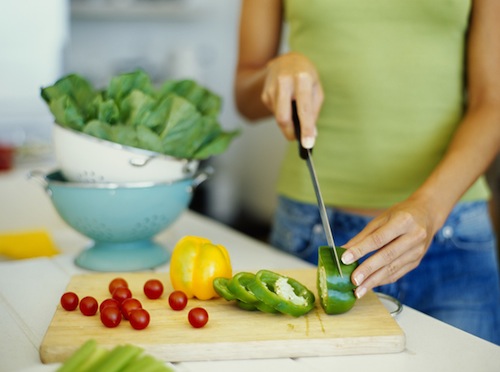During the month of April, as we celebrate all that is wonderful about our planet, we challenge you to green every room of your house—starting with the room that holds a very special place in our hearts, the kitchen. We love spending time with family & friends sharing new recipes, cooking great foods and creating unforgettable conversations. Our kitchen is one of the busiest rooms in the house, which makes it one of the best places to start when looking to do a green makeover this spring.
Take these steps to move your kitchen into a greener space:
Keep It Clean
While you may be well-versed in how to handle raw foods, you may be missing some opportunities to keep your kitchen free from bacteria and germs. At the end of each day wipe down countertops, cabinets and fronts of appliances with a natural, eco-friendly cleaner such as our Ecospirit™ All-Purpose Cleaner and put your sponge in the microwave. Yes, the microwave. According to Health.com, three out of four kitchen sponges and rags test positive for potentially dangerous bacteria. Putting your sponge in the microwave on medium for a minute helps clean the sponge and reduce the chance of you spreading the bacteria to other surfaces and dishes.
Conserve Water
If you think running the dishwasher uses more water than washing by hand, think again—washing a load of dishes in a dishwasher actually uses LESS water than washing dishes by hand. Some tips from WebMD.com: make sure your dishwasher is full before you run it and always use the “economy” setting if that is available on your brand. You can also save a little energy while saving water—let your dishes air-dry instead of using the heat-dry option.
Reduce Your Recyclables
While many kitchens have recycling bins, consider reducing the amount of recyclable items your family uses. For example, instead of purchasing water bottles, invest in a water filter for your faucet or a water filter pitcher to keep in your fridge. Use dish cloths and napkins instead of paper products, use glass containers instead of plastic wrap for keeping leftovers and purchase a reusable grocery bag instead of deciding between paper or plastic.
Repurpose Your Food
Here is an alarming statistic from Inhabitat.com: Americans wasted 33 million tons of food in 2010. To help alleviate this issue, consider creating a compost system. Inhabitat suggests using an indoor odor-minimizing composter or, if you have the outdoor space, checkout tips from howtocompost.org. A side benefit to composting is that you may be able to use the nutrient-rich soil to create your own garden.
Become Your Own Chef
Instead of buying pre-packaged and often processed food, make it yourself. In addition to always knowing what you’re eating, you are reducing the energy it takes to process and transport your food and reducing waste by eliminating the packaging. If you really want to green your food preparation, buy local whenever you can by visiting local farmers’ markets or joining your local community supported agriculture (CSA) co-op. Another great benefit to making your own food? It’s a great way to get kids into the kitchen.
Talk to us: What are you doing to move your kitchen into a greener space?

